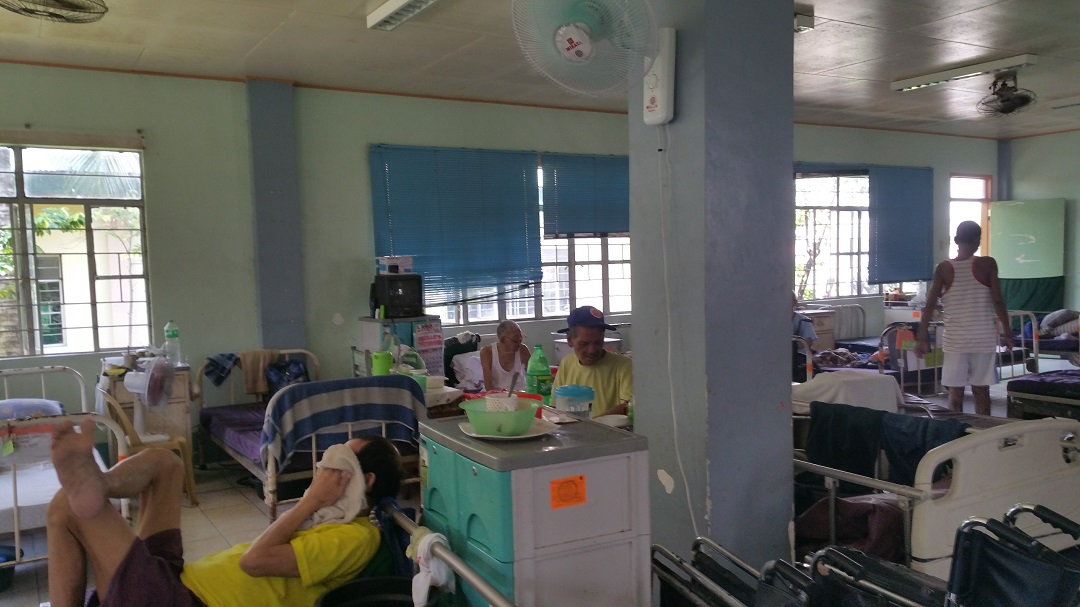Manila: Day 2

After sleeping for around 12 hours (the second time that week), I got up and prepared for my second day in Manila. Going downstairs, I met with one of the priests and we chatted until the rest of our group arrived. On today's agenda, we would be visiting the local hospital that one of the parishioners works at and seeing the leper wards.
After breakfast, all six of us hopped on a motorcycle (three of us in a sidecar, two standing on the back of the sidecar, and one sitting behind the driver on the motorcycle) and headed to the hospital. Our guide gave us a rundown of the services provided and the general information on the hospital and ER areas. Due to it being a Sunday, the clinic was closed, with all incoming patients going to the ER area at the bottom of the hospital.
Going through the hospital, I couldn't help but be overwhelmed by the feeling of sickness in the air. Since there were not enough hospital rooms on any of the floors, patients were setup in each floor lobby and hospital staff erected makeshift walls. I reached the point where I had to leave the building because I felt too overwhelmed. This was strange for me because I've always enjoyed going to the hospital, and at that point I began to see why many people dread it.
We were able to take a break in the hospital chapel, which one of the cured lepers (called partners) was in charge of maintaining. Once we finished our short break, we headed over to the blood donation station, which had been newly created and was providing blood to the hospital. Before, the hospital had to send a truck to the blood bank to receive blood, but since the construction of the donation center, they are able to receive and store blood on site.
After our tour of the hospital, we made our way to the outskirts of the hospital grounds to the leper wards. Our guide had been working with the lepers for over a decade, and knew many of them personally. He showed us all the wards and talked to us about the future expansion of the hospital grounds, hoping to provide better care and facilities to those afflicted with leprosy.
We were even able to interview one of the lepers and hear about his story and how he has been able to push through this disease without losing hope. One of my main objectives in going there was to clear away any of the misconceptions about leprosy and help educate people on what it's really like. In our interview with our guide, he was able to explain more about leprosy, but I'll try to summarize what he said.
To preface, going into this, the only thing I knew about leprosy was that they were some people who were shunned by everyone else and Jesus healed them from time to time. Other than that, I just pictured them to be covered in blisters and sores and living in pain. Also, to avoid them so that I don't get leprosy. Here's what I learned:
- Once cured, leprosy is no longer contagious.
- There is still a strong stigma about leprosy since people don't know that it isn't contagious once cured.
- Since the hospital started treating lepers, not one case of the disease passing to a hospital staff has been reported.
- Most lepers will be abandoned by their families due to this stigma and find their new homes in local cured-leper communities.
What I learned on my trip helped me understand this group of people more and how necessary this work is to help these marginalized people.
We also visited a nearby community that was providing housing for some cured lepers and I was able to interview the president of the community, who was a cured leper. He explained to me the heartache that comes with leprosy, explaining that once people find out you are either a leper or even a cured leper, they will avoid you and shun you. Not only by their families but by potential employers as well.
After leaving the hospital, we came back to the house to have lunch and another siesta. In the afternoon, we headed back out into the community to see four of the communities that were constructed to provide housing and education to lepers and their families.
The sizes of these communities varied, though on average, they housed around 15 to 20 families. There was one community that constructed a school and provided education to the children of lepers.
After we finished our tour of the cured leper communities, we headed home to have dinner and transfer all the photos and videos.
After dinner, I worked on organizing all my belongings and prepared for my trip back home. By the time I got home, I had worked two 24 hour days that week and had seen more pain and sickness than I ever had. My eyes were definitely opened to the brokenness of the world, and how easy life can be in America. For reference, I can get a full lunch for around one to two dollars, and public transportation to work costs about 15 cents.
